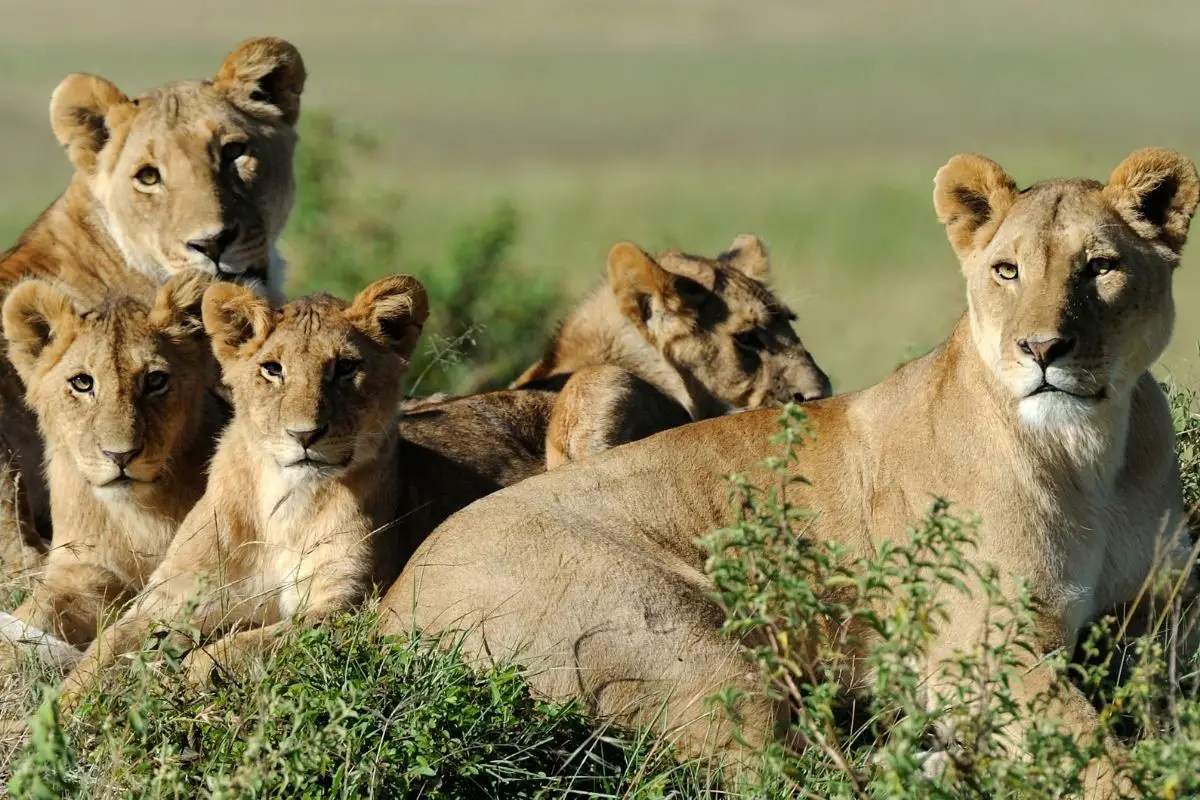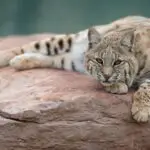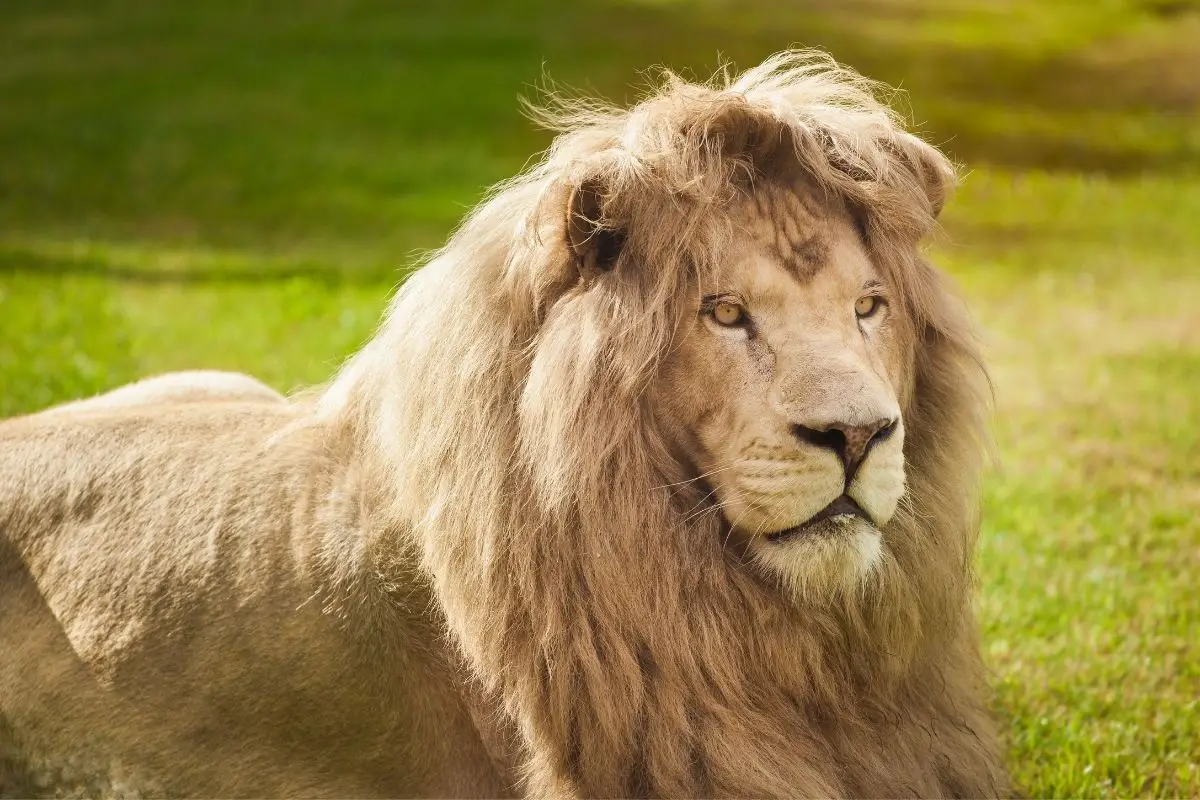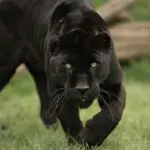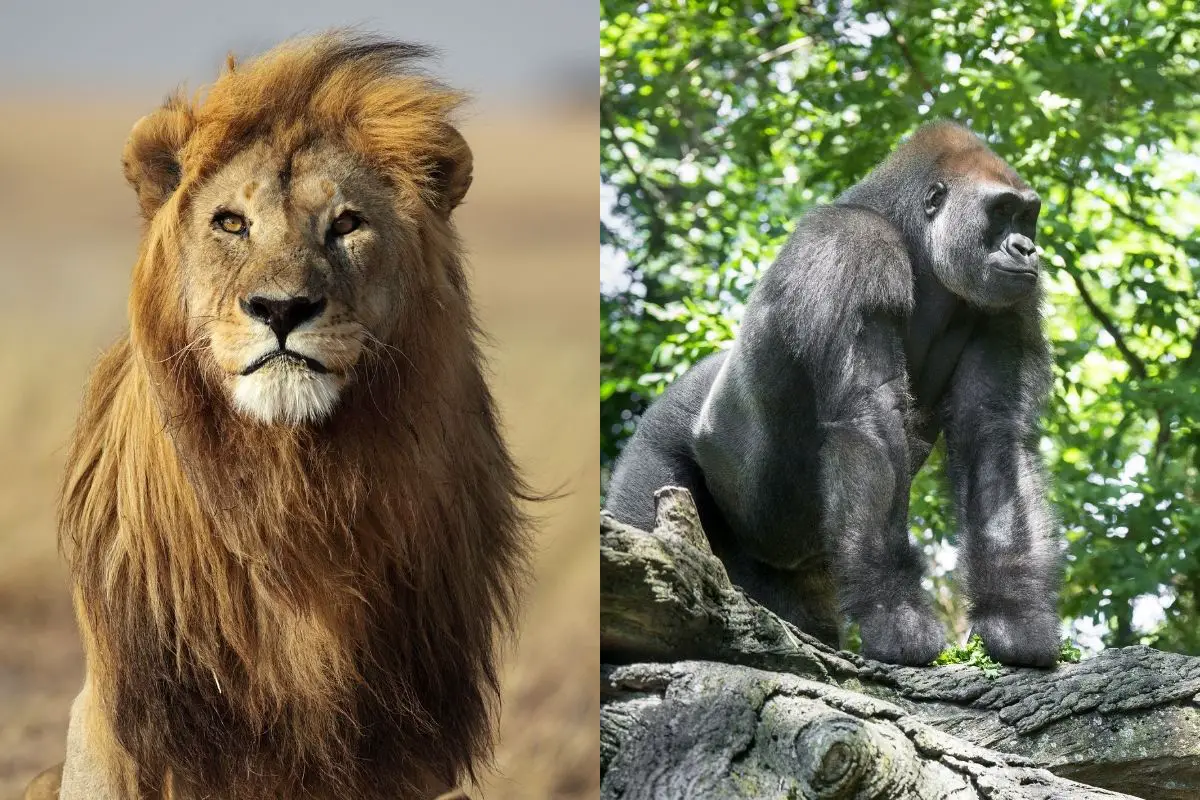The African lion, apex predator and “King of the Beasts,” might rule the savanna, but even royalty has enemies. In 2025, conservation research reveals that lions face an increasingly complex web of threats from fellow predators, massive herbivores, and environmental pressures that challenge their dominance like never before.
Recent GPS collar studies across Kenya, Tanzania, and Botswana show that what animals hunt and threaten lions has evolved dramatically over the past decade. Climate change, habitat fragmentation, and shifting prey patterns have created new predator dynamics that wildlife biologists are still working to understand. Understanding these threats is crucial for lion conservation efforts and helps explain why lion populations have declined by 43% since the 1990s.
The Hierarchy of Threats: Who Really Challenges Lions in 2025
Modern wildlife research using camera traps, GPS tracking, and behavioral analysis has revealed that lion threats operate on multiple levels. Unlike the simplified predator-prey relationships often portrayed in documentaries, the reality of African ecosystems involves complex competitive relationships where lions are simultaneously hunters and hunted.
Current threat categories facing lions include:
- Apex competitors: Other large predators competing for territory and prey
- Megafauna threats: Massive herbivores capable of killing lions in defensive encounters
- Pack hunters: Coordinated predators that can overwhelm individual lions
- Opportunistic threats: Animals that target vulnerable lions or cubs
- Human-related dangers: The fastest-growing threat category in 2025
Primary Predators: Animals That Actively Hunt Lions
Spotted Hyenas: The Persistent Pack Hunters
Spotted hyenas represent the most consistent predatory threat to lions, particularly in areas where clan sizes have grown due to increased carrion availability from human activities. According to the National Geographic Society’s latest research, hyena clans have adapted their hunting strategies specifically to target isolated or weakened lions.
In 2025, hyena threats to lions include:
- Coordinated pack attacks: Clans of 20-50 hyenas can overwhelm small lion prides
- Cub predation: Hyenas actively hunt lion cubs when adults are absent
- Harassment campaigns: Persistent following and intimidation to steal kills
- Territorial displacement: Large clans can force lions from prime hunting areas
Recent studies show hyenas are responsible for up to 30% of lion cub mortality in some regions, making them one of the most significant threats to lion population recovery.
African Wild Dogs: Elite Pack Hunters
African wild dogs, though smaller individually than lions, pose a serious threat through their exceptional pack coordination and stamina. These endangered predators have hunting success rates of up to 80%—far higher than lions’ 25%—and their persistence can exhaust and isolate lions from their prides.
Wild dog packs threaten lions by:
- Using relay hunting techniques to tire out individual lions
- Targeting isolated lions separated from their pride
- Competing aggressively for the same prey species
- Harassing lions with coordinated mobbing behavior
Other Male Lions: Intraspecies Competition
Perhaps the deadliest threat to lions comes from their own species. Male coalition warfare represents one of the most brutal aspects of lion society, with takeover attempts resulting in high mortality rates for both cubs and adult males.
[Table: Lion vs Lion Mortality Statistics – showing survival rates during territorial disputes]
Defensive Killers: Herbivores That Can Destroy Lions
African Elephants: The Unbeatable Giants
Elephants remain the most formidable threat to lions in 2025, and their protective behavior has become increasingly aggressive as habitat pressure mounts. Adult elephants can weigh 40 times more than a male lion and possess the intelligence to coordinate anti-predator strategies.
Modern elephant-lion conflicts show:
- Proactive hunting: Elephant matriarchs actively seek out and chase lions from their territory
- Coordinated defense: Herds form protective circles around calves
- Memory-based aggression: Elephants remember and avoid areas with recent lion activity
- Water source dominance: Elephants can deny lions access to crucial water during dry seasons
For insights into the complex relationship between these species, explore our detailed analysis of whether lions actually hunt elephants.
Cape Buffalo: Africa’s Most Dangerous Prey
Cape buffalo kill more hunters annually than any other African species, and this deadly reputation extends to their interactions with lions. In 2025, buffalo populations in some areas have developed increasingly sophisticated anti-predator behaviors.
Buffalo threaten lions through:
- Herd charging: Coordinated stampedes that can trample entire prides
- Gore attacks: Curved horns capable of inflicting fatal wounds
- Protective formations: Adults form barriers around young calves
- Pursuit behavior: Buffalo will chase fleeing lions for considerable distances
Hippopotamuses: Territorial Water Guards
Hippos represent a unique threat to lions due to their amphibious lifestyle and extreme territorial aggression around water sources. With bite forces exceeding 4,000 PSI, hippos can literally crush lions in their massive jaws.
Hippo-lion conflicts typically occur during:
- Dry season water competition
- Accidental territorial intrusions
- Lions hunting near riverbanks
- Hippo calving seasons when aggression peaks
Rhinoceros: Living Tanks of the Savanna
Both black and white rhinoceros species can kill lions through their charging attacks and horn goring. Rhinos’ poor eyesight makes them particularly unpredictable, as they may charge perceived threats without proper threat assessment.
Aquatic Ambush Predators
Nile Crocodiles: Ancient Apex Predators
Large Nile crocodiles represent one of the few animals capable of consistently killing healthy adult lions. These ancient predators have remained virtually unchanged for millions of years, perfecting ambush techniques that make water sources dangerous for all terrestrial animals.
According to research from the World Wildlife Fund, crocodile attacks on lions have increased in areas where human water diversion has concentrated both species around remaining water sources.
Crocodile advantages over lions:
- Bite force: 5,000+ PSI compared to lions’ 650 PSI
- Ambush capability: Nearly invisible when submerged
- Death roll technique: Rotational attacks that disorient and drown prey
- Armor plating: Scales that deflect lion claws and teeth
The Human Factor: 2025’s Biggest Threat to Lions
In 2025, humans represent the most significant and fastest-growing threat to lion populations. Unlike other predators, humans threaten lions through multiple mechanisms simultaneously, making human-lion conflict the primary conservation challenge of our time.
Direct Human Threats
Modern human threats to lions include:
- Retaliatory killing: Farmers protecting livestock from lion predation
- Trophy hunting: Legal and illegal hunting operations
- Traditional medicine: Demand for lion parts in various cultural practices
- Accidental poisoning: Secondary poisoning from pesticides and rodenticides
Indirect Human Pressures
Habitat fragmentation and climate change driven by human activities create cascading effects:
- Prey species migration patterns disrupted
- Water sources contaminated or diverted
- Natural corridors blocked by development
- Disease transmission from domestic animals
Understanding big cat behavior and safety is crucial for reducing human-wildlife conflict. Our comprehensive guide on mountain lion deterrent strategies provides valuable insights applicable to lion encounters.
Unexpected Threats: Small but Deadly Dangers
Porcupines: The Quilled Killers
African porcupines might seem like unlikely threats to apex predators, but these small mammals are responsible for surprising numbers of lion deaths annually. Their defensive quills can cause fatal infections when they penetrate sensitive areas like the mouth, paws, or nose.
Porcupine-related lion mortality occurs through:
- Embedded quills preventing eating, leading to starvation
- Secondary infections from quill wounds
- Jaw injuries that permanently disable hunting ability
- Paw punctures that impair mobility
Venomous Snakes: Silent but Lethal
Several African snake species pose lethal threats to lions, particularly in areas where habitat destruction forces closer contact. Black mambas, puff adders, and Gaboon vipers all possess venom potent enough to kill lions.
Disease Vectors: Invisible Killers
In 2025, disease has emerged as a major lion threat, with several key pathogens causing population declines:
- Feline immunodeficiency virus (FIV): Weakens immune systems
- Canine distemper: Transmitted from domestic dogs
- Bovine tuberculosis: Spread through infected prey
- Anthrax outbreaks: Natural and potentially weaponized strains
Seasonal Threat Variations in 2025
Lion threat patterns have shifted significantly due to climate change, with traditional seasonal behaviors disrupted by unpredictable weather patterns and changing prey availability.
Dry Season Intensification
Extended dry seasons in 2025 have created unprecedented competition around limited water sources:
- Increased elephant-lion conflicts at waterholes
- Higher concentrations of dangerous prey species
- More frequent crocodile encounters
- Weakened lions more vulnerable to all threats
Flooding and Wet Season Challenges
Extreme weather events have created new threat scenarios:
- Displaced crocodiles in flood zones
- Disease outbreaks in crowded refuge areas
- Prey scarcity during extended wet periods
- Increased human-wildlife conflict in flood-affected areas
Conservation Implications and Threat Management
Understanding what threatens lions is essential for effective conservation strategies. Modern conservation efforts must address multiple threat vectors simultaneously while considering changing environmental conditions.
Multi-Species Corridor Development
Creating wildlife corridors that account for lion threat patterns helps reduce dangerous encounters while maintaining ecosystem balance. These corridors must consider:
- Seasonal migration patterns of both lions and their threats
- Water source accessibility and safety
- Buffer zones around human settlements
- Alternative prey availability
Human-Wildlife Conflict Mitigation
Successful lion conservation requires addressing human threats through:
- Livestock protection programs
- Community compensation schemes
- Alternative livelihood development
- Education and awareness campaigns
For broader context on big cat conservation and behavior, explore the fascinating cultural significance of tigers and how human perceptions influence conservation efforts.
Future Threats: Emerging Challenges for 2025 and Beyond
Several emerging threats require immediate attention from conservation communities:
Climate Change Impacts
- Shifting prey distributions forcing lions into unfamiliar territories
- Extreme weather events creating mass mortality incidents
- Desert expansion reducing available habitat
- Changed rainfall patterns affecting breeding cycles
Technological Threats
- Illegal poaching using advanced tracking technology
- Habitat disruption from increased mining and drilling
- Noise pollution affecting hunting and communication
- Light pollution disrupting natural behavior patterns
Frequently Asked Questions About Lion Threats
Q: What is the biggest threat to lions in 2025?
A: Humans represent the largest and most complex threat to lions in 2025, affecting them through habitat destruction, direct killing, climate change, and prey depletion. Human activities impact lions both directly and indirectly across all aspects of their lives.
Q: Can a single animal kill a healthy adult male lion?
A: Yes, several animals can kill healthy adult lions, including large crocodiles, elephants, buffalo, hippos, and rhinoceros. However, lions typically avoid direct confrontations with these dangerous species when possible.
Q: Which predator is most successful at killing lions?
A: Other lions (male coalitions) are statistically the most successful at killing adult lions, followed by large hyena clans. Intraspecies competition accounts for more lion deaths than any single external predator.
Q: Do lions have any natural defense against their threats?
A: Lions use several strategies including pride cooperation, territorial marking, avoidance behaviors, and alliance formation. Their social structure is their primary defense against most threats.
Q: How has climate change affected what threatens lions?
A: Climate change has intensified competition around water sources, altered prey migration patterns, and forced lions into more frequent contact with dangerous herbivores and human settlements.
Q: Are there any animals that lions never hunt due to threat level?
A: Lions typically avoid hunting healthy adult elephants, hippos, and rhinoceros due to the extreme danger these animals present. They may target young, old, or sick individuals of these species under specific circumstances.
Conclusion: The Complex Reality of Lion Survival in 2025
The question of what animals hunt and threaten lions reveals a far more complex ecosystem than simple predator-prey relationships suggest. In 2025, lions face an unprecedented combination of traditional predators, defensive mega-herbivores, human pressures, and environmental challenges that test their adaptability like never before.
From the persistent threat of hyena clans to the crushing power of elephants, from the ambush tactics of crocodiles to the growing pressure of human expansion, lions must navigate an increasingly dangerous world. Understanding these threats is crucial not just for wildlife enthusiasts, but for conservation efforts that depend on comprehensive threat assessment and mitigation strategies.
The survival of lions into the future will depend on our ability to address these multiple threat vectors simultaneously. This includes protecting critical habitat, managing human-wildlife conflict, maintaining ecological balance, and adapting to climate change impacts. Every threat lions face is ultimately connected to the health of the entire African ecosystem.
As we continue to study and protect these magnificent predators, remember that even the King of Beasts faces enemies. This vulnerability doesn’t diminish their majesty—it makes their survival story even more remarkable and their conservation even more urgent.
For a deeper understanding of big cat behavior and feeding patterns, explore our comprehensive guide on mountain lion dietary preferences to appreciate the broader context of apex predator survival strategies.
- Bengal Cat vs Wild Bengal Tiger: Complete Comparison 2025 - October 31, 2025
- Complete Wild Cat Spotting Guide for Hikers 2025 - October 31, 2025
- Lynx vs Bobcat: Complete Field Identification Guide 2025 - October 30, 2025

